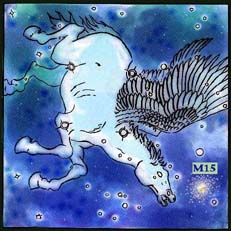

By CASSIE FERGUSON
Illustrations by RICK JONES
A night sky offers a kaleidoscope of cosmic creatures, the glow of a nebulae, the fiery tail of a comet, and the wash of the rest of the Milky Way. Among the shifting menagerie lurk the dinosaurs of the universe, globular clusters. Thousands, and even millions, of stars have been crowding into these clusters since the beginning of the universe, gathering like slow-moving swarms of insects around a light.One of the most crowded of the clusters has also been attracting a host of astronomers to its dazzling heart. Globular cluster M15 has been a puzzle to sky gazers since the 1700's, when French comet hunter Charles Messier spotted the cluster as a faint patch of light in the constellation Pegasus. Armed with more powerful telescopes, astronomers after Messier began to peer more closely at M15. As they gazed at the stellar gathering, the astronomers began to wonder what could be going on in the intensely crowded cluster center.
_______________________
The globular cluster M15 lies
in the constellation Pegasus.
On a clear night, the millions
of stars are visible through a
pair of binoculars. _______________________"In some clusters, of which M15 is a prime example, things get very crowded in the center, like a big city. Just as in a city, extra things can happen when it gets crowded. Stars might even physically collide with one another, and a variety of strange products might be formed. Pairs of stars might be whizzing rapidly around each other, like the Moon around the Sun," explains Ruth Peterson of the University of California Lick Observatory.
If M15 were a city, the stars would all be rushing downtown. Researchers such as Michael Bolte of the University of California at Santa Cruz hope to learn more about the crowded center of globular clusters because, "... in many ways they are like mini-laboratories in which we can study how stars interact when you put lots of them in a relatively small volume." Observations from these mini-labs, he says, can be applied to cluster evolution and the evolution of galaxies such as our own. In the past few decades, theorists have devised two explanations for the stars' rush to the cluster center. Either the stars are pulled towards the center by a phenomenon called a core collapse, or they are heading towards a massive black hole.



